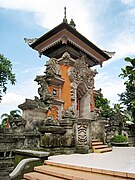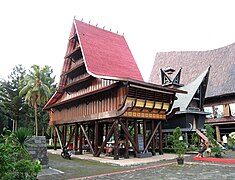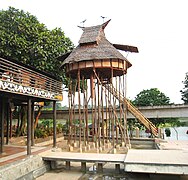Taman Mini Indonesia Indah
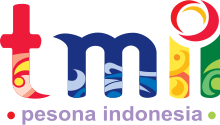 | |
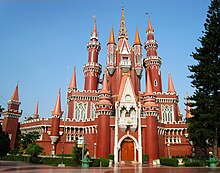 Indonesian Children Castle at TMII | |
| Location | Jakarta Timur, DKI Jakarta, Indonesia |
|---|---|
| Coordinates | 6°18′6″S 106°53′48″E / 6.30167°S 106.89667°ECoordinates: 6°18′6″S 106°53′48″E / 6.30167°S 106.89667°E |
| Slogan | Kunjungi Taman Mini, Cintai Indonesia (Visit Taman Mini, Love Indonesia) |
| Owner | Government of Indonesia |
| Operated by | Ministry of State Secretariat |
| General manager | Tanribali Lamo |
| Opened | 20 April 1975 |
| Visitors per year | 2000 |
| Area | 1 |
| Attractions | |
| Total | 5 |
| Roller coasters | 1 |
| Water rides | 2 |
| Website | www |
| Status | Operating |
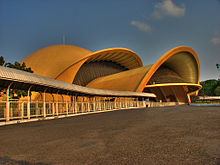
Taman Mini "Indonesia Indah" (literally "Beautiful Indonesia" Mini Park, abbreviated as TMII) is a culture-based recreational area located in East Jakarta, Indonesia. Since April 2021, it is operated by the Government of Indonesia through the Ministry of State Secretariat; it was formerly operated by Yayasan Harapan Kita, a foundation established by Siti Hartinah, the first lady during most of the New Order and wife of Suharto, and still run by Suharto's descendants since his death. It has an area of about 100 hectares (250 acres).
The park is a synopsis of Indonesian culture, with virtually all aspects of daily life in Indonesia's 26 (in 1975) provinces encapsulated in separate pavilions with the collections of rumah adat as the example of Indonesian vernacular architecture, clothing, dances and traditions are all depicted impeccably. Apart from that, there is a lake with a miniature of the archipelago in the middle of it, cable cars, museums, Keong Emas IMAX cinema (Indonesia's only IMAX cinema until the 2010s), a theater called the Theatre of My Homeland (Theater Tanah Airku) and other recreational facilities which make TMII one of the most popular tourist destinations in the city.[1]
Since 2007 Taman Mini Indonesia Indah launched new logo with branding slogan Pesona Indonesia (Indonesian Charm).
On December 31, 2014 World Peace Committee decided TMII as International Civilization Park and World Peace Theme Park.[2]
History[]
The idea of presenting Indonesia on a small scale was conceived by former Indonesian first lady, Siti Hartinah, better known as Tien Suharto. It came about at a convention on 8 Cendana Street on March 13, 1970. Through this recreational site, she hoped to cultivate national pride in more Indonesian people.[1] A project called "Indonesian Miniature Project" was started by Harapan Kita Foundation in 1972. The concept of this culture-based recreational area was inspired by Indonesia's unparalleled natural riches and local folk diversity.
Characteristics[]
TMII was originally located on a public area of 145 ha, as farms and fields. Later, the team was able to convert these fields into a suitable location for the construction. The topography of TMII is rather hilly, consistent with what the builders required. The team claimed the advantage of utilizing this uneven terrain was the ability to create interesting and diverse landscapes and enclosures, as well as reflecting the various characteristics of the Indonesian environment.[1]
Parts of TMII[]
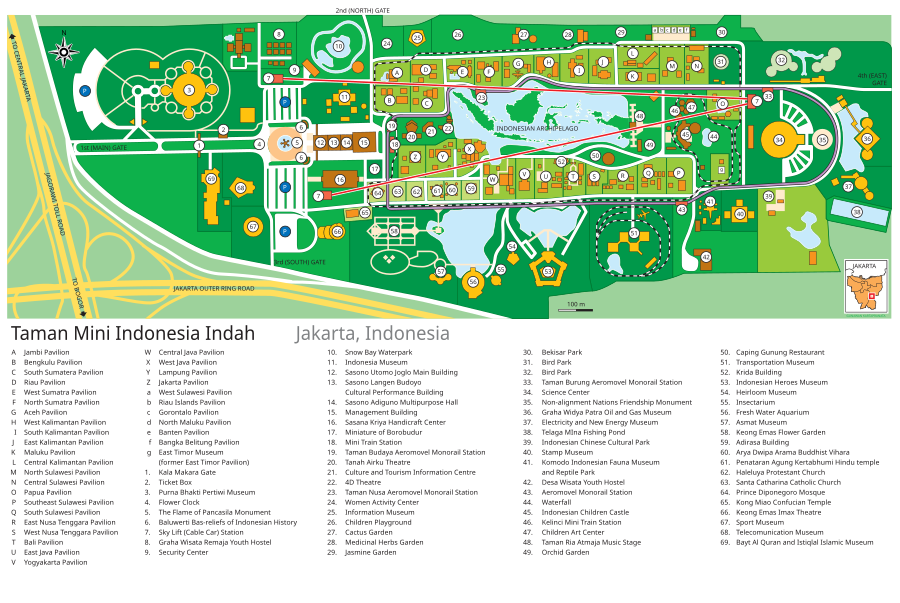
Venues of Indonesian provinces[]

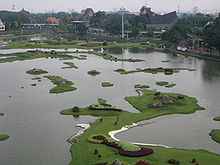

Since each Indonesian province maintains its own unique and distinct cultures, shelters, attire and dialects, TMII built a model of each of the houses from Indonesian provinces. TMII attempted not only to reconstruct the homes of the various provinces, but also to create a realistic model of the environment and shelters of the various people of Indonesia.[3] The venues, which are situated around the main lake in a similar fashion to the different islands of the Indonesian archipelago, are thematically divided into six areas in respect to the main islands of Indonesia; Java, Sumatra, Kalimantan (Borneo), Sulawesi, the Lesser Sunda Islands, Maluku and Papua. Each pavilions featured in typical vernacular Indonesian architecture of each provinces. Examples of Indonesian traditional vernacular houses are: Joglo and Omah Kudus Javanese houses of Central Java and Yogyakarta pavilion; Minang Rumah Gadang of West Sumatra pavilion; Malay houses of Jambi and Riau provinces; Torajan Tongkonan and Bugis house of South Sulawesi pavilion; and Balinese house compound with intricately carved candi bentar split gate and kori agung gate.
It also displays various traditional costumes, wedding costumes, dance costumes, also ethnography artifacts such as weapons and daily tools, models of traditional architecture are in display to describes the way of life of its people. Each provinces pavilions also equipped with small stage, amphitheatre or auditorium for traditional dance performances, traditional music performances or traditional ceremonies that usually held in Sundays. Some of these pavilions also equipped with cafeterias featuring traditional Indonesian cuisines and also souvenir shops offering various handicrafts, T-shirts and souvenirs.
Since 1975 until the 2000s, the original design of TMII consists of a model of the traditional houses (rumah adat) from the 27 provinces of Indonesia, including East Timor. But after the secession of East Timor from Indonesia in 2002, the East Timor pavilion changed its status to become the Museum of East Timor. Since Indonesia now consists of 34 provinces, the new province pavilions of Bangka Belitung, Banten, West Sulawesi, North Maluku, Gorontalo, Riau Islands, and West Papua has been built in northeast part of the park, although the size and area of the newly built pavilions is much smaller than the previously built pavilions.
After the recognition of Indonesian Chinese culture as an integral part of Indonesian culture in 2000, the new Indonesian Chinese pavilion and a Confucian temple was built within the park.
Religious buildings[]
The religious buildings of several official faiths is meant to showcase the inter-faiths tolerance and religious harmony of Indonesia. The religious buildings are:
- Pangeran Diponegoro Mosque
- Santa Catharina Catholic church
- Haleluya Protestant church
- Penataran Agung Kertabhumi Balinese Hindu temple
- Arya Dwipa Arama Buddhist temple
- Sasana Adirasa Pangeran Samber Nyawa
- Kong Miao Confucian temple
Gardens and parks[]

There are about ten gardens spread within TMII complex, but most are located primarily on the north and northeast side of the main lake:
- Orchid Garden
- Medicinal herbs Garden
- Cactus Garden
- Jasmine Garden
- Keong Emas (Golden Snail) Flower Garden
- Taman Ria Atmaja Park, stage and music performances
- Taman Budaya Tionghoa Indonesia, an Indonesian Chinese cultural park (under construction)
Taman Burung (Bird Park)[]
Taman Burung is divided into five exhibits: Kubah barat (West dome) which include birds from the Greater Sunda Islands (Except Sulawesi) and the Lesser Sunda Islands, kubah timur (East dome) which include birds from Sulawesi, the Maluku Islands, and New Guinea, a free ranging river exhibits, raptor aviaries, and other aviaries and exhibits scattered around the park. The park also own several birds from outside of Indonesia, such as birds from China, Africa, Australia, and South America.
Free ranging river[]
Kubah Barat[]
Free ranging:
- Javan pied myna
- Common myna
- Javan myna
- Bali myna
- Zebra dove
- Green junglefowl
- Javan peafowl
- Lesser whistling duck
- Glossy ibis
- Eastern cattle egret
- Woolly-necked stork
- Black crowned crane
Housed in aviaries:
- Wreathed hornbill
- Common pheasant
- Greater Bornean crested fireback
- Black hornbill
- Rhinoceros hornbill
- Black-winged starling
- Bali myna
- Crested partridge
- Black-naped oriole
- Asian glossy starling
- Common emerald dove
- Silver-tipped imperial pigeon
- Nicobar pigeon
- Australasian swamphen
- Straw-headed bulbul
- Pied stilt
- Javan peafowl
- Great argus
- Sunda laughingthrush
- Sumatran laughingthrush
- Asian koel
Raptor aviaries[]
- Crested serpent eagle
- Javan hawk-eagle
- White-bellied sea eagle
- Brahminy kite
- Changeable hawk-eagle
Kubah Timur[]
- Domestic pigeon
- Pied imperial pigeon
- Masked lapwing
- Western crowned pigeon
- Maleo
- Nankeen night heron
- Papuan hornbill
- Moluccan king parrot
- Black-capped lory
- Eclectus parrot
- White cockatoo
- Salmon-crested cockatoo
- Palm cockatoo
- Yellow-crested cockatoo
- Red bird-of-paradise
Other species[]
Multiple exhibits for the southern and northern cassowary are located near the exit. A small aviary housing Java sparrow and streaked weaver can be found near the park's food storage.
Birds, like the Oriental magpie-robin, twelve-wired bird-of-paradise, Tanimbar corella, grey parrot, silver pheasant, Indian peafowl, and multiple species of songbirds, were kept off display for breeding purposes.
Museum Serangga[]
Museum Serangga is invertebrates museum that have collections from around Southeast Asia. The Museum also have live insect exhibits, and small mammal park. The museum also have a breeding facility on certain type of butterfly.
Dunia Air Tawar[]
Dunia Air Tawar is the second largest freshwater and brackish themed aquarium in Asia. The park has 6000 animals of 126 species, including reptiles, amphibian, crustaceans, and fish.
Outdoor pond[]
- Koi
- Nile tilapia
- Iridescent shark
Entrance[]
- Super red arowana
- Trumpet knifefish
- Three-lined glass knifefish
- Black ghost knifefish
- Argentine eartheater
- Discus
- Xingu River ray
- Angelfish
- Denison barb
Tunnel aquarium[]
- Bigtooth river stingray
- African sharptooth catfish
- Redtail catfish
- Hoven's carp
- Pirapitinga
- Silver arowana
- Yellow tail silver arowana
- Albino iridescent shark
- Giant pangasius
Gourami room[]
- Giant gourami
- Giant red tail gourami
- Kissing gourami
- Osphronemus septemfasciatus
- Chocolate gourami
- Three spot gourami
- Pearl gourami
- Siamese fighting fish
Indoor pond[]
- Pirarucu
Arowana hall[]
- Leucistic alligator gar
- Gulf saratoga
- Super red arowana
- Red-tailed golden arowana
- Golden dorado
- Leucistic Florida gar
Second floor aquariums[]
- Paradise threadfin
- Goonch
- Spotbanded scat
Indoor waterfall[]
- Koi
- Yellow tail silver arowana
- Leucistic iridescent shark
Room 1[]
- South American lungfish
- Asiatic glassfish
- Red-bellied piranha
- Oscar
- Tucanare peacock bass
- Blind cave fish
Room 2[]
- Blind cave fish
- Blackberry silver dollar
- Metynnis fasciatus
- Neon tetra
- Alligator gar
- Hoven's carp
- Striped Raphael catfish
- Driftwood catfish
- Barred sorubim
- Sun catfish
- Ripsaw catfish
- New Guinea tandan
Room 3[]
- Chinese warty newt
- Gold barb
- Grass carp
- Clown loach
- Bonylip barb
- Albino tinfoil barb
- Blood parrot cichlid
- Wolf fish
- Bigtooth river stingray
- Tinfoil barb
- Koi
- Red-eared slider
Room 4[]
- Pirapitinga
- Pirarucu
- Tor douronensis
- Pao palembangensis
- Crystal-eyed catfish
Archerfish pond[]
- Banded archerfish
- Common archerfish
4D Cinema Hall[]
- Indonesian shortfin eel
- Albino arowana
- Freshwater moray eel
Nusantara room[]
Displaying species native to Indonesia. The room contain 34 aquariums representing the provinces of Indonesia, each contain species native to the specific provinces. Additionally, the Nusantara room showcases two paludarium.
Room 5[]
- Yellow tail silver arowana
- Giant pangasius
- Striped wallago catfish
- Flowerhorn cichlid
- Silver prochilodus
- Geophagus altifrons
- Electric yellow cichlid
- Fahaka pufferfish
- Congo tetra
Riverine exhibit[]
- Albino softshell turtle
- Hoven's carp
- Hoven's carp
- Alligator snapping turtle
- Iridescent shark
- Redtail catfish
- Tambaqui
Room 6[]
Room 7[]
- Blue salmon catfish
- Black sharkminnow
- Tinfoil barb
- Oranda
- Asian swamp eel
- Barred bichir
- Saddled bichir
- Zig-zag eel
- Snakehead gudgeon
- Giant sword minnow
Amazonia[]
- Ocellate river stingray
- Bigtooth river stingray
- Silver dollar
- Heros efasciatus
- Pinktail chalceus
- Banded leporinus
Exit[]
Taman Legenda[]
A dinosaur and Indonesian folklore themed park.
Technological Centre[]
Pusat peragaan Iptek or Science and Technology Display Centre is under coordination of Research and Technology Ministry. At the end of 2011 has 15 sites with about 300 science tools and visited by 341,000 visitor in a year. The sites are Robotic, Electric and Magnet, Mechanics, Mathematics, etc.[4]
Museums[]


There are fourteen museums at TMII:
- Indonesia Museum
- Purna Bhakti Pertiwi Museum
- Soldier Museum
- Indonesian stamps Museum
- Pusaka (Heirloom) Museum
- Transportation Museum
- Museum Electricity & New Energy Museum
- Telecommunication Museum
- Penerangan Museum
- Sports Museum
- Asmat Museum
- Komodo Indonesian Fauna Museum and Reptile Park
- Insects Museum
- Research & Technology Information Centre
- Oil & Gas Museum
- East Timor Museum (former East Timor province pavilion)
Theatres[]
- Keong Emas (Golden Snail) Imax Theater
- Tanah Airku Theater
- 4D Theater
Monuments, halls, buildings and other exhibits[]


- Kala Makara main gates
- Flower clock
- Tugu Api Pancasila, the main monument, an obelisk celebrating Pancasila
- Baluwerti, a twin gate with relief of Indonesian history on its wall
- Pendopo Agung Sasono Utomo (Grand Hall), the main building in Javanese Joglo style
- Sasono Utomo, exhibition hall
- Sasono Langen Budoyo, indoor stage and theater
- Sasono Manganti
- Sasana Kriya, multi purpose function hall
- Park Management Office
- Cokot Sculpture, a display of wooden sculptures by Cokot, a famous Balinese artist
- The Miniature of Borobudur
- APEC Memorial Monument and Garden
- Non Alignment Nations Friendship Monument and Garden
- The Miniature of Indonesian Archipelago on central lake
- Indonesian Archipelago Plaza and Stage
- Jati Taminah, a remnant of a large teak tree
- Kayu Gede (large wood), the display of large tree trunk
Rides[]
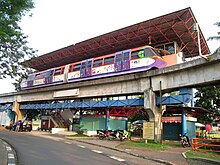
- Skylift Indonesia cable car
- SHS-23 Aeromovel Indonesia, a wind powered people mover
- Mini train around the park (Permanently Closed)
- Boat ride on Indonesian archipelago lake
- Swan paddle boat on Indonesian archipelago lake
- Bicycle rent ride
- Car ride around the area
Recreation facilities[]

- Istana Anak-Anak Indonesia (Indonesian Children Castle)
- Taman Among Putro kiddy rides park
- Desa Seni dan Kerajinan handicraft center
- Rare books market
- Snowbay Waterpark swimming pool
- Telaga Mina fishing pond
- Warna Alam outbound camp
Lodgings[]
- Desa Wisata hostel
- Graha Wisata Remaja youth hostel
Restaurants[]
- Caping Gunung restaurant
- California Fried Chicken restaurants
- Pecel Madiun restaurant
- Various cafetarias and warungs available throughout the park featuring Indonesian cuisines such as soto, gado-gado, nasi goreng and satay.
Plans[]
As of 2011 the operator planned to disburse $35 million for building a new Discovery World theme park. A 2-hectare area was to be built and it was predicted to be operated before the end of 2012. It would serve 100 venues/rides and was predicted to attract 1.2 million visitors from Indonesia and Southeast Asia.
TMII area would be connected with of Greater Jakarta LRT Line 1, which is currently under construction.
Gallery[]

Tourists take a ride on this cable car to enjoy bird-eye view of this park

Riau dancers
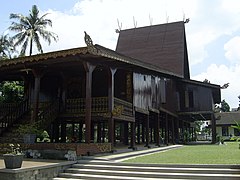
South Kalimantan pavilion in TMII
Bali pavilion gate
Toba Batak house at North Sumatra pavilion
Nias house at North Sumatra pavilion
Baluk house at West Kalimantan pavilion
Jambi pavilion
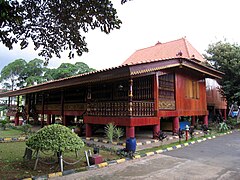
South Sumatra pavilion

Riau pavilion

Malay house at Riau pavilion

Aceh pavilion

Toraja house, South Sulawesi pavilion

Bugis house, South Sulawesi pavilion
A joglo at Central Java pavilion
Interior of Javanese Joglo house, Central Java pavilion

Kong Miao Confucian temple

Swan pedalo rides at archipelago lake
Sources[]
- ^ Jump up to: a b c History Archived 2006-09-01 at the Wayback Machine
- ^ "TMII Ditetapkan Sebagai Wahana Perdamaian Dunia". December 31, 2014.
- ^ Anjungan
- ^ "TMII Luncurkan Wahana Robotik". February 1, 2012. Archived from the original on February 2, 2012.
External links[]
| Wikimedia Commons has media related to Taman Mini Indonesia Indah. |
- (in Indonesian) Official website
- Operating amusement attractions
- Taman Mini Indonesia Indah
- Amusement parks in Indonesia
- Parks and lakes in Jakarta
- Buildings and structures in Jakarta
- Open-air museums in Indonesia
- Post-independence architecture of Indonesia
- Tourist attractions in Jakarta
- Museums in Jakarta
- 1975 establishments in Indonesia
- Cultural centers in Indonesia





